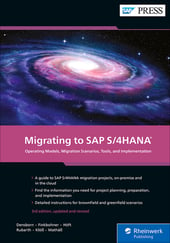Learn how to simplify SAP S/4HANA production system deployment with SAP Cloud Appliance Library, leveraging hyperscaler integration for faster, customized, and production-ready setups.
SAP Cloud Appliance Library, via which the SAP S/4HANA Fully-Activated Appliance is used particularly frequently, is a simple and valuable way to build test and evaluation systems.
Since 2022, SAP Cloud Appliance Library now provides the option of deploying systems at a hyperscaler that can also be used in production. This approach is called production-ready deployment and is based on a tight integration with the hyperscaler tools. It’s currently offered for Microsoft Azure as a hyperscaler.
Compared to the SAP S/4HANA Fully-Activated Appliance, this approach not only has the advantage of providing production systems, but also the systems can be based on a company-specific SAP installation stack. This includes, for example, the selection of components, especially the add-ons to be installed, but also the names for hosts, system ID, and any high availability (HA) and type HA setup. After selecting the desired parameters, the system is automatically deployed and in a short time is embedded in the tools of the hyperscaler, for example, in the Microsoft Azure portal.
Compared to a manual installation, with the production-ready deployment, the system is available in a shorter time, standardized, and with less manual effort.
After logging into SAP Cloud Appliance Library, you’ll find the starting points for the production-ready deployment in the Products section.

The products are listed there based on the SAP S/4HANA target versions, for example, 2022. If you select such a product, details will be listed (see next figure). You can then start the deployment for this target using the Deploy Default Plan link with the default setting.

In the Custom Installation Plans section, you’ll also find a list of Transactions IDs that are based on custom Maintenance Planner installation plans.
If you’ve already planned an installation in Maintenance Planner, this planning can be used here.
However, you can also start a new plan at this point, that is, directly from SAP Cloud Appliance Library, using the Create Installation Plan link. Then a wizard embedded in the UI opens, through which you can store the desired parameters that Maintenance Planner requires. You don’t need to open Maintenance Planner in a separate window for planning.
In the next figure, the steps can be seen in the upper line of the wizard. After step 1 (System Details), in which you specify the system ID and plan name, in step 2 (Add-ons), you need to select the desired add-ons, such as SAP Ariba. Steps 3 (OS/DB Files) and 4 (Stack Files) correspond to the installation planning steps directly in Maintenance Planner.

After completing the wizard, you can reference the newly created plan in SAP Cloud Appliance Library as the starting point of the system deployment, as shown.

Now you need to follow the steps for the system and infrastructure configuration. You must assign a Microsoft Azure account to your library tenant, which either already exists or can be newly created here.
After specifying all relevant parameters, the automatic deployment follows within hours after the start of the deployment. Compared to a manual installation, which can take days, this is a significant simplification. You can monitor the deployment process in SAP Cloud Appliance Library using the individual steps. At the end, you’ll be shown the connection data for logging in to the system. The external IP can also be used to find the system in the Microsoft Azure portal in its own cloud account in the virtual machines area.
For information on production-ready systems, see the following SAP Community page: http://s-prs.co/v581672.
SAP Cloud Appliance Library features will continue to be added in the future to further support you on your journey to SAP S/4HANA. For example, it’s planned that the installation of the application server host at the hyperscaler is simplified in the case of combined system conversion with a move to the hyperscaler (using the Data Migration Option [DMO] procedures).
Editor’s note: This post has been adapted from a section of the book Migrating to SAP S/4HANA: Operating Models, Migration Scenarios, Tools, and Implementation by Frank Densborn, Frank Finkbohner, Martina Höft, Boris Rubarth, Petra Klöß, and Kim Mathäß.



Comments